What is a Future Narrative?
Data-Design Dictionary
A dictionary to illuminate data-driven generative design and creative coding.
A Future Narrative is a narrative form characterized by features such as openness, indeterminacy, virtuality, and the inclusion of a variety of possible continuations of individual events[1]. It creates a space of possibilities in which events – influenced, for example, by characters’ decisions, actions, values, or motives – can branch out in different directions at specific junctures.
At the heart of Future Narratives is the creation of a “space of possibilities.” This conceptual space is where events unfold in numerous ways, influenced by the decisions, actions, values, and properties of a dataset. This narrative style, in which openness, indeterminacy and dependence on external influences are already inherent, offers an ideal analogy for the development of concepts with the possibilities of generative design, as both approaches are characterized by their rejection of linearity. In generative design, the nodes of future narratives are precisely those design decisions that are inscribed in the program by creative professionals and that later, in conjunction with the data influencing the program, lead to the unique expression of the form.

The significance of Future Narratives lies in their ability to create a meaningful connection between ideas, programs, forms, and stories. By emphasizing the interplay between predetermined elements (nodes) and the fluidity of potential outcomes, Future Narratives provide a rich framework for understanding and designing complex systems and narratives.















